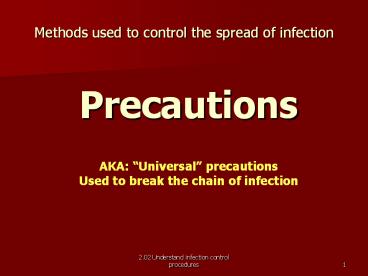Infection Control - PowerPoint PPT Presentation
Title:
Infection Control
Description:
Methods used to control the spread of infection Precautions AKA: Universal precautions Used to break the chain of infection 2.02 Understand infection control ... – PowerPoint PPT presentation
Number of Views:1056
Avg rating:3.0/5.0
Title: Infection Control
1
Methods used to control the spread of infection
Precautions
AKA Universal precautions Used to break the
chain of infection
2
Standard Precautions
- Used on ALL patients
- Includes
- Hand washing
- Personal Protective Equipment (PPE)
- Gloves
- Gowns
- Masks and eye protection
- Needle stick safety
- Sharps
- Spills and splashes
- Resuscitation devices
- Waste and linen disposal
- Injuries
3
PPE
- Use when there is risk of contact with any blood
or body fluid - Secretion
- Excretion
- Mucous membrane
- Non-intact skin
- Tissue specimen
4
Standard Precautions
- Hand washing
5
Standard Precautions
- Personal protection equipment (PPE)
6
Methods used to control the spread of infection
Standard Precautions
- Gloves
7
Standard Precautions
- Gowns
8
Standard Precautions
- Masks and eye protection
9
Standard Precautions
- Needlestick safety
10
Standard Precautions
- Sharps
11
Standard Precautions
- Spills and splashes
12
Standard Precautions
- Resuscitation devices
13
Standard Precautions
- Waste and linen disposal
14
Standard Precautions
- Injuries
15
Bloodborne Pathogen Standard
- Blood human blood, blood components, blood
products - Bloodborne pathogens disease causing organisms
in blood - Examples
- (Hep. B, Hep. C, HIV)
16
Bloodborne Pathogen Standard
In an emergency, you may not be able to
identify body fluids or tell whether they contain
blood, treat all body fluids as potentially
infectious.
17
Bloodborne Pathogen Standard
- Applies to all occupational exposure of blood or
other potentially infectious material. - Always remember safety when using
equipment/supplies
18
Be Aware
- Never re-cap needles
- Use sharp containers
- Use resuscitation devices
- Reduce exposure to BBP by using PPE
19
Methods used to control the spread of infection
Tuberculosis Standard
- OSHA Standard to reduce occupationally
transmitted/acquired TB - Requires FIT tested and training in the use of
specific respiratory PPE - PPD skin test annually
20
Methods used to control the spread of
infectionExtended Infection Control Precautions
- Standard Precautions PLUS
- Airborne Precautions
- Contact Precautions
- Droplet Precautions
21
Extended Infection Control Precautions
- Transmission based precautions
- Additional precautions used with patients
infected with pathogens that are spread via - airborne transmission
- droplet transmission
- direct contact
- Requires isolation
22
Airborne precautions
- Pts door must be close
- pathogens are transmitted by airborne droplets
suspend in air or on dust particles - prevents the spread of illnesses such as measles
(rubella) , chicken pox (varicella), TB
(tuberculosis), and shingles (Herpes Zoster) - Specific PPEs-
- HEPA respirators are required for HCP
- HCP must be fit tested for a Hiigh Efficiency
Particulate Respirator (HEPA)
23
Contact precautions
- Anything that comes in contact with pt is
contaminated - Indirect/direct
- Pt must be in private room
- Needed for diseases that can be easily
transmitted - Diapered or incontinent pts with intestinal
infections
24
Contact precautions
- Helps prevent spread of GI, respiratory, skin, or
wound infections - Specific PPEs
- gloves
- gowns
25
Droplet precautions
- Most infection occurs within 3ft of pt
- Droplets are heavy and usually fall to floor
within 3 ft range - Droplets come from
- Coughing, sneezing, talking and laughing
26
Droplet precautions
- Helps prevent the spread of bacterial and viral
flu, meningitis, pneumonia, sinsusitis, otitis
media, diptheria, pertussis, adenoviruses, mumps - Specific PPEs-
- Mask/face shield if working within
- 3 ft of patient
27
Protective or reverse precautions
- Used to protect pt
- Example
- Compromised immune system
- Cancer
- AIDS
28
All Precautions
- Limit use of non-critical care equipment to
single pt - Wash hands before and after care
- Bag linen to prevent contamination to self,
environment, or outside of bag - Double bag and discard infectious trash
- Limit transport of pt
- Follow PPE for pt illness































